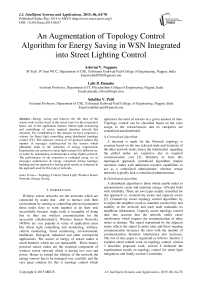An Augmentation of Topology Control Algorithm for Energy Saving in WSN Integrated into Street Lighting Control
Автор: Ashwini V. Nagpure, Lalit B. Damahe, Sulabha V. Patil
Журнал: International Journal of Intelligent Systems and Applications(IJISA) @ijisa
Статья в выпуске: 6 vol.7, 2015 года.
Бесплатный доступ
Energy saving and improve the life time of the sensor node is main focus in the recent years for the researchers hence one of the application domain (Street light monitoring and controlling) of sensor required attention towards this direction. For contributing in this domain we have proposed a scheme for Street light controlling using distributed topology control (TC). The optimize version of A3 protocol reduces the number of messages send/received by the sensors which ultimately leads to the reduction of energy requirement. Experiments are carried on street light scenario for different no. of nodes by maintaining communication using Zigbee protocol. The performance of our extension is evaluated using, no. of messages send/receive & energy consumed during topology building and our approach is having good results as compared to the approach used for this type of network.
Topology Control, Street Light, Wireless Sensor Network, Energy Saving
Короткий адрес: https://sciup.org/15010724
IDR: 15010724
Текст научной статьи An Augmentation of Topology Control Algorithm for Energy Saving in WSN Integrated into Street Lighting Control
Published Online May 2015 in MECS
-
A. Centralized algorithm
A decision is made for the Network topology is examine based on the one selected node and locations of the other network nodes, hence the information regarding the global nodes are expensive due to required communication cost [2]. Similarly to form this topological approach, centralized algorithms require one/more nodes with additional resource capabilities to act as a centralized administrator, whereas sensor networks typically lack a centralized administration.
-
B. Distributed algorithm
A distributed algorithm is those which enable nodes to autonomously create and maintain energy- efficient links with reliability. There are two types mainly classified for this approach i.e. connectivity aware and capacity aware [2]. Connectivity aware topology control algorithms try to adjust the neighbor count to maintain connectivity and stability in the network and each node maintains its neighbour information. Capacity aware topology control take into account that the network nodes cause interference which impacts the communication of other nodes in domain. The signal transmitted by the adjacent nodes affects the signal to noise ratio and these ongoing communication increases the ratio with the number of communications therefore interference also increases. The rest of this paper is organized as follows: Section 2 explains about related work on topology control, section 3 describes proposed work, section 4 elaborate the experimental results on topology control for street light integration, and finally section 5 concludes.
-
II. Related Work
The contribution to minimize the energy requirement is previously done by so many researchers and still the work is continuing towards this direction. Specifically most of the work for the domain of WSN is done using topology control [15] and some of those works are discussed here. Xiaoyu Chu and Harish Sethu [3] introduce (CTCA) algorithm that dynamically adapts to current energy levels at different node and introduces a game-theoretic to maximize the network lifetime. Similarly for the connectivity of nodes, concept of graph theory is not sufficient due to heterogeneous traffic in WSN and due to path- implementability ability of sensor nodes to relay traffic along a given direction field is good representation [4].
Paolo Costa et al. [5] proposes a cooperative distributed approach which dynamically adjusts the transmission power of sensor nodes to match connectivity constraints and the optimization for this distributed topology control is gain by the mathematical programming. To extend the lifetime of wireless network and balance the nodes energy consumption, the technique propose by Ruozi Sun et al. [1] creates the MST, based on energy-aware weighted graph. The dynamic topology control (WDTC) algorithm and MST helps to adjust the network topology. Similarly Saeid Taghavi et al. [17] proposed, fully localized and distributed algorithm called CL Neigh for Topology Control, which exchange the few messages and maintained power level of the node at actual hardware level. The useful properties of this algorithm, is the network connectivity will be kept but not any guarantee to preserve worst-case connectivity.
Cluster head selection is important issue and SEP is the important contribution in the field of WSN for selecting the cluster head and hence Manju Bala et al. [18] proposed the Deterministic-SEP based algorithm which apply on the two cases of two-level and four cases of three-level heterogeneity. The reported performance is good and energy depletion slope per round is lower in comparison with SEP protocol. But the adaptation of dynamic topology control is also important consideration but this type of approach mainly leads to the computational and communicational complexity. Energy Balanced Topology Control (EBTC) prposed by the , Xiaoyu Chu et al. [6] is minimizes the complexity. Similarly Color Based Topology Control (CBTC) algorithm was introduced by the A. Khan et al. [7] for dense network which reduces the energy loss.
The heuristics approaches can be a important in terms of redundancy in connection of WSN because the traditional methods are not so efficient for optimization. A PSO based optimization [8] technique called as a non dominated discrete particle swarm optimization (NDPSO) has been designed. This approach provides the controllable communication and improves the overall lifetime of WSNs. The variance in the transmitting power decides the role of network whether it belongs to homogeneous or heterogeneous and such a work on heterogeneous environment is given by Nanxi Luo and Jie Bao [9], based on pass-loss.
For the formation of virtual backbone CDS-based topology control technique is used to allow communication between nodes. Topology control using localized protocols [10] constructed k-connected dominating set (k-CDS) as a virtual backbone of wireless networks. The extension of CDS proposed by Jie Wu at el. [11] is used an ad hoc network and 2 hops cooperative communication but it transmit independent copies of a packet, which create effects of fading. The suboptimised version called as A3 algorithm [12] applied in distributed environment which turn off some nodes by keeping full network connection. The performance of this approach is measures in terms of number of active nodes, message complexity, and energy efficiency.
Sajjad at el. [13], further optimize the virtual backbone of A3 algorithm and this so called A1 algorithm perform better in terms of message overhead, connectivity under topology maintenance and sensing coverage. The application of A3 and its evolution on the street light [14] is also a better initiative in the domain of topology control but it needs further optimization for message overhead problem, hence in the given work we try to minimize this problem, which ultimately leads to drop the rate of energy consumption.
-
III. Proposed Work
The implementation of WSN networks and the augmentation of the performance level are important issues and that should not be neglected. The main two energy consuming operations of a WSN node are the communication (sending/receiving bits) and the local calculations that must be performed quickly by the respective node. However, a well-known fact is that the transfer of information also demands twice the energy consumption of the information storage, computation and monitoring of the data sent by various sensors. Therefore, the establishment of communication must become more efficient in terms of energy consumption.
In the proposed work we use extension of A3 algorithm named as A3 augment. The A3 algorithm proposed by the P.M Wightman et. al. [12] uses four messages i.e. hello message, parent recognition message, children recognition message and sleep message. The hello, parent recognition and sleep massage are considered as a short message which would requires 25 bytes of size whereas child recognition considered as a long message which is requires 100 bytes of size. The no. of messages and the size of messages transmit and received by the sensors is responsible for consuming energy. In Sleeping mode sensor nodes are shut down or work in a low power-mode and hence a sleeping node cannot participate either in sensing or relaying. But, it wakes up periodically and listens to communication channels. Hence the proposed extension A3 augment minimizes the no. of messages send/received by the sensors which ultimately reduces the consumption of energy and this can be done by eliminating the use of sleep message and ultimately A3 augment algorithm reduces energy consumption. The Next section discuss about the Algorithm.
-
A. A3 Augment Algorithm
Assumptions:
-
a) Nodes are located in a two dimensional space and have a perfect communication coverage disk.
-
b) During transmission one/more nodes are considered to be a sink node and remaining are the regular nodes.
-
c) Sink node is a node who initiates the transmission.
-
d) Nodes have no information about their position, orientation, or neighbors.
-
e) The initial graph, is formed right after the deployment, is connected.
-
f) Distances can be calculated as a metric perfectly proportional to the Received Signal Strength Indicator (RSSI).
Step1: A3 augment algorithm uses three massages namely Hello message, parent recognition message and children recognition message.
Step2: First of all sink node broadcast hello massage.
Step3: The nodes which are in the range of the sink node accept that hello message.
Step4: The nodes which accept the hello message, send parent recognition message to sink node in reverse and with Parent recognition message node sends their metric which include remaining energy and distance.
Step5: Sink node accept this parent recognition message and sort the list in descending order according to metric and broadcast it with children recognition message.
Step6: The nodes which accept this message compare the list with each other and the node which is having less timeout that node will go in active state and other nodes will go in sleep state automatically based on their order in the list. Go to step 2.
-
B. Design of Street light scenario
The objective of the proposed algorithms is to design such a sensor network which will simulate the environment of street lighting. Street light is controlled and monitor by the sensor nodes and this operation is best optimized with the help of Topology control concept of the wireless sensor nodes.
In case of the street light network, lights are normally placed at the equal distance from each other. The distance is usually considered as a 50m-70m from two poles for standard lighting environment. The designed street light scenario for 67 nodes and 106 nodes is shown in the fig 1 which is created manually, depicts the node deployment.
The scenario for 67 nodes is designed based on the 70m distance whereas the other is based on 50m distance from each node. The communication area is reflected by the Zig-bee protocol whose range is max 100m and sensing range is considered to be the 20m.
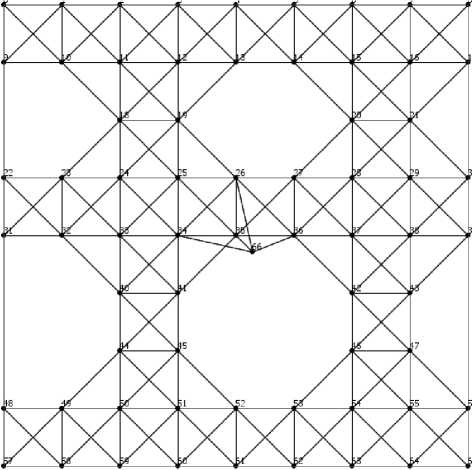
a)
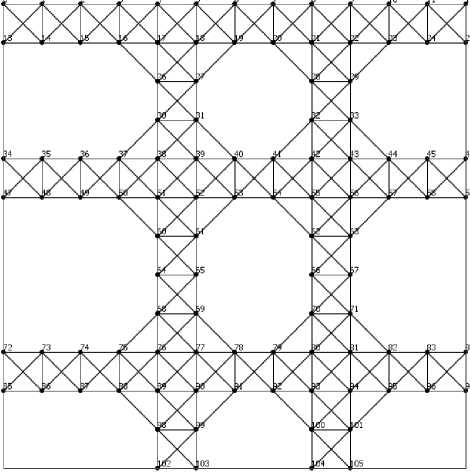
b)
Fig. 1. Design of street light network a) using 67 nodes b) using 105 nodes
-
IV. Experimental Setup and Results
Our objective is to design such a sensor network which will simulate the environment of street lighting. The street light is controlled and monitor by the sensor nodes and this operation is best optimized with the help of Topology control concept. The simulation of street light scenario and the proposed algorithm are performed using the well defined event driven simulator of topology control called Atarraya [16]. The augmented approach of algorithm is implemented using this tool and deployment of node is done according to the street Network configuration. Initially the nodes are deployed (560 ×560) between the distance of 70m by keeping the communication and sensing range 100m and 20 m respectively. The sink node and remaining nodes is assumed to have the initial energy of 1000mJoule/Node. The details of simulation parameters used for the different experiment is shown in Table 1.
Mainly two types of experiments are carried out to evaluate the designed algorithm. These varieties of experiment are used for investigating the effect of node density on the proposed algorithm and energy consumed by the network and the nodes.
|
Parameters |
A3 |
A3 Augment |
A3 |
A3 Augment |
|
Area |
560 × 560 m |
600 × 600 m |
||
|
No. of Nodes |
66 |
105 |
||
|
Sink Node |
1(Node No. 67) |
1(Node 105) |
||
|
Communication Range |
100m |
|||
|
Sensing range |
20m |
|||
|
Total Energy Initial |
67000 mJoule |
106000 mJoule |
||
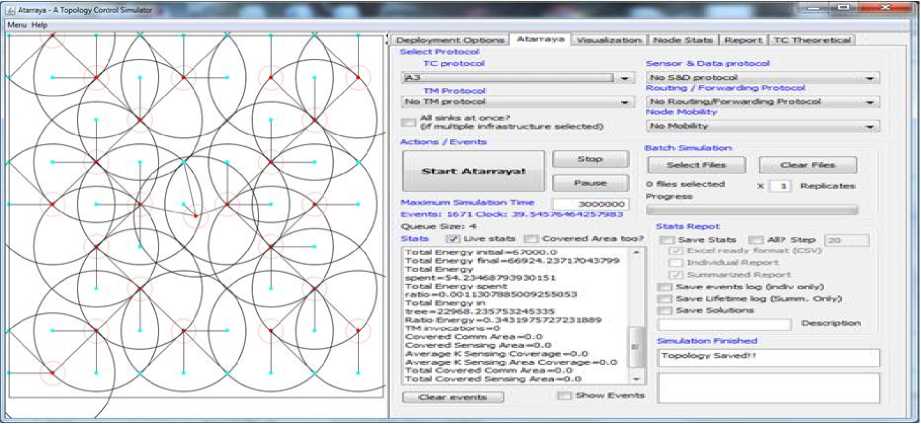
a)
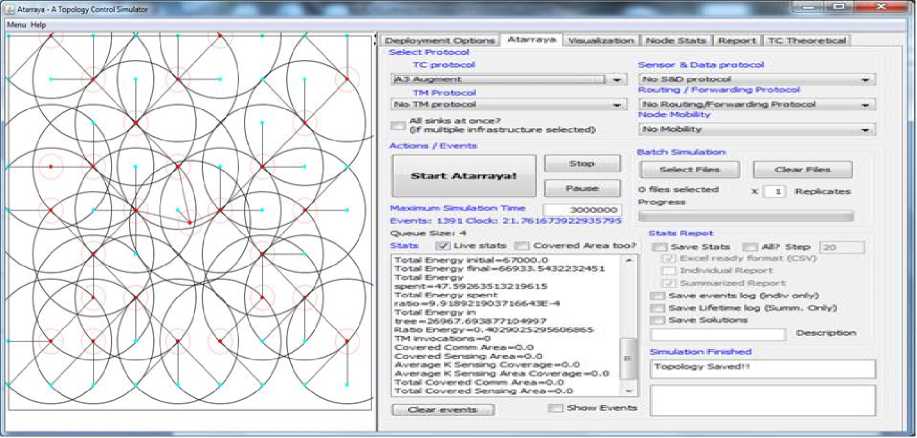
b)
Fig. 2. For 67 nodes Street Network Deployment showing a) A3 communication with reduced topology and A3 live status for energy utilization b) A3 augment communication with reduced topology and live status for energy utilization
An Augmentation of Topology Control Algorithm for Energy Saving in
WSN Integrated into Street Lighting Control
-
A. Experiment 1: 67 Nodes
Initially experiment carried on the 67 nodes for the A3 algorithm and our approach. The nodes are deployed and different types of parameters which mainly include the selection of protocol, simulation time, live status etc. are set before running the simulation. After running the simulation by selecting the A3 and our approach varieties of screens will appears as shown in fig. 2, which display the live status of both the protocol. In live status other parameters are also considered as per the standard of simulator but we mainly concentrate on the energy consume by the network and it is observed that our approach is covers all the nodes and having less energy consumption.
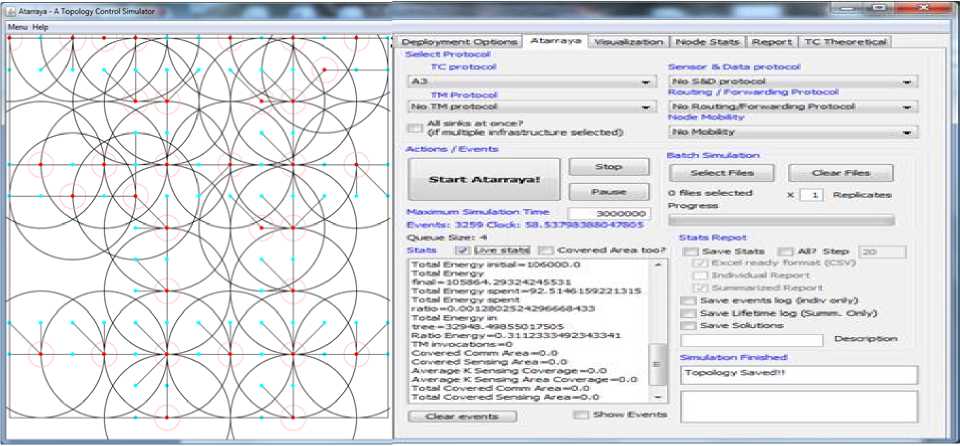
a)
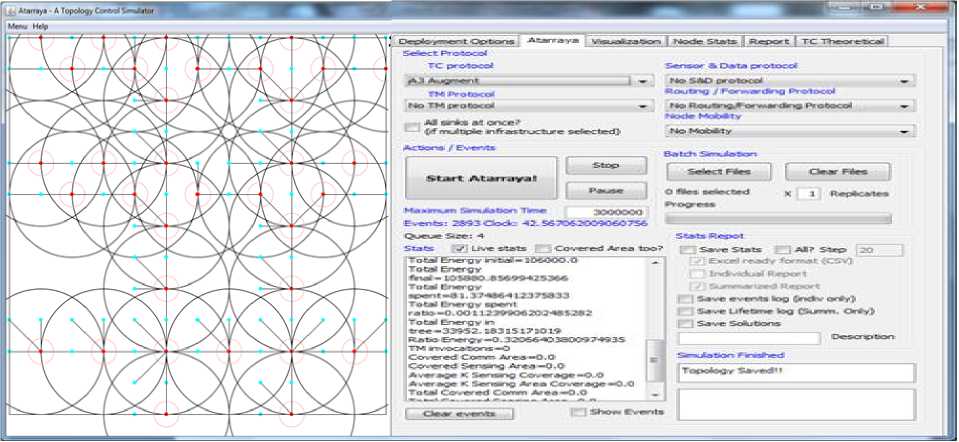
b)
Fig. 3. For 106 nodes Street Network Deployment showing a) A3 communication with reduced topology and live status for energy utilization b)A3 augment communication with reduced topology live status for energy utilization
-
B. Experiment II: 106 Nodes
energy, remaining energy and energy spend. Our approach mainly include the reduction of sleep messages ,i.e. no needs to be send messages individually like in case of A3 hence the reduction of energy spend is observed in live status.
The aim of designed algorithm is to minimize the no. of event and maximize the network lifetime. In both the experiment we are using the standard parameters which is already set by simulation tool for energy consumed/bit and occurrence of event is nothing but the communication established by the nodes. Experimentally it is observed that, the no. of events will be less in case of smaller network whereas more for bigger network. Similarly it is also observed that the less no. events will occur in case of our approach.
The Atarraya simulator is message or event driven tool and hence in each communication (transmission/ reception) energy is consumed. The no. of messages sends and received by the A3 and A3 Augment algorithm is shown in figure 4. The no of messages sent and received for the 67 nodes arrangement are 214 and 1056 in A3 whereas in case of our extension they are 170 and 845. Similarly for the 106 nodes results are shown in fig. 4 (a).
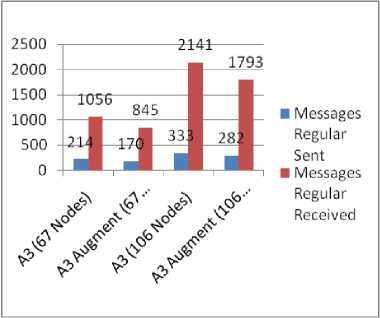
a)
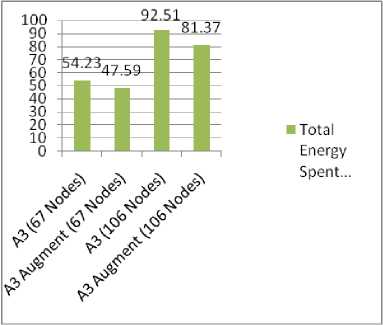
b)
Fig. 4. A3 and Augmented A3 a) Total no. of Messages Send/Received b) Total Energy Spend
The less no. messages improve the capacity of the nodes to work for longer time.
For the CDS based techniques the lifetime are based on the CDS nodes that remain alive during the backbone formation and to achieve the objective of energy saving for street lighting, the reduced no of messages in our proposed technique prolong the life span of the nodes over a given period of time. As the no of messages decreases, energy utilization is also decreases (figure 4 b) which ultimately lead to improve the overall lifetime of the network.
A network’s lifetime is strongly dependent on battery lifetime and hence the energy saving is the main focus for the topology control. A CDS based technique is good alternative in the direction of optimization. The proposed technique are evaluated for the application of street lighting environment and the simulation performed under control environment shows that the messages send and received by the given approach is less as compared to A3 protocol and hence it reduces the total energy consumption and help to improve the lifetime of nodes. Further investigation is required to minimize the no. of messages for the larger area of deployment.
Список литературы An Augmentation of Topology Control Algorithm for Energy Saving in WSN Integrated into Street Lighting Control
- D. J. Cook and S. K. Das, “Smart environments: technologies, protocols and applications”, New York: John Wiley, pp. 13-15, 2004.
- G. Srivastava, P. Boustead, and J. F. Chicharo, “A Comparison of Topology Control Algorithms for Ad-hoc Networks”, Proceedings of the Australian Telecommunications, Networks and Applications Conference ATNAC03, Melbourne,Australia December 8, 2003.
- X. Chu and H. Sethu, "Cooperative topology control with adaptation for improved lifetime in wireless ad hoc networks", INFOCOM, 2012 Proceedings IEEE , vol., no., pp.262,270, 25-30 March 2012.
- M. Haghpanahi, M. Kalantari and M. Shayman, “Topology control in large-scale wireless sensor networks: Between information source and sink”, Ad Hoc Networks, Volume 11, Issue 3, pp.975-990, May 2013.
- P. Costa, M. Cesana, S. Brambilla, and L. Casartelli, “A cooperative approach for topology control in Wireless Sensor Networks”, Pervasive and Mobile Computing, Volume 5, Issue 5, pp. 526-541, October 2009.
- X. Chu and H. Sethu ,“An Energy Balanced Dynamic Topology Control Algorithm for Improved Network Lifetime”, Computer Science Networking and Internet Architecture 12 sep 2013
- M. Khan, A. Khan, S. Shah, A. Abdullah” An Energy Efficient Color Based Topology Control Algorithm for Wireless Sensor Networks”, Wireless Sensor Network ,Vol. 5 Issue 1,pp.1-7, Jan 2013.
- W. Guo, B. Zhang, G. Chen, X. Wang, and Naixue Xiong, “A PSO-Optimized Minimum Spanning Tree-Based Topology Control Scheme for Wireless Sensor Networks”, Hindawi Publishing Corporation International Journal of Distributed Sensor Networks ,Volume, Article ID 985410, pp. 1- 14 , 2013.
- N. Luo and J. Bao, “A Topology Control AlgorithmBased on Pass Loss forWireless Sensor Network”, applied Mechanics and Materials, Volumes 347 – 350, pp. 677-681, August, 2013.
- F. Dai and J. Wu, "On Constructing k-Connected k-Dominating Set in Wireless Networks", Parallel and Distributed Processing Symposium, 2005. Proceedings. 19th IEEE International , vol., no., pp.81a,81a, 04-08 April 2005.
- J. Wu, M. Cardei, F. Dai; S.Yang, "Extended Dominating Set and Its Applications in Ad Hoc Networks Using Cooperative Communication", Parallel and Distributed Systems, IEEE Transactions on , vol.17, no.8, pp.851-864, Aug. 2006.
- P.M Wightman and M.A. Labrador, "A3: A Topology Construction Algorithm for Wireless Sensor Networks”, Global Telecommunications Conference, IEEE GLOBECOM 2008 , vol., no., pp.1,6, Nov. 30-Dec. 4, 2008.
- S. Rizvi, H. K. Qureshi, S. Ali Khayam, V. Rakocevic, and M. Rajarajan, “A1: An energy efficient topology Energy Reduction: An Extension of Topology Control for Street Light Scenario International Conference on Electrical, Electronics and Computer Science (ICEECS-2014) ISBN: 978-3-643-24819-07, Nagpur, 15th June, 2014.
- L. Alexandru, P. Valentin, "Performance evaluation of topology control algorithms that can be integrated into a street lighting control sensor network ", published in Roedunet International Conference (RoEduNet), 2013,17-19 Jan. 2013.
- A. V. Nagpure and S. Patil “Topology Control in Wireless Sensor Network: An Overview”, International Journal of Computer Applications, New York, USA, Vol. 92 - Number 7 , pp.13-18, April 2014
- P.M Wightman, M.A. Labrador, “Atarraya: a simulation tool to teach and research topology control algorithms for wireless sensor networks”, In: Create-Net 2nd international conference on simulation tools and techniques, SIMUTools; 2009.
- Saeid Taghavi Afshord, Bager Zarei, Bahman Arasteh,"A New Distributed and Power-Efficient Topology Control Algorithm for Wireless Ad-Hoc Networks", IJCNIS, vol.5, no.12, pp.20-26,2013.
- M. Bala, & L. Awasthi,"Proficient D-SEP Protocol with Heterogeneity for Maximizing the Lifetime of Wireless Sensor Networks", IJISA, vol.4, no.7, pp.1-15, 2012.

